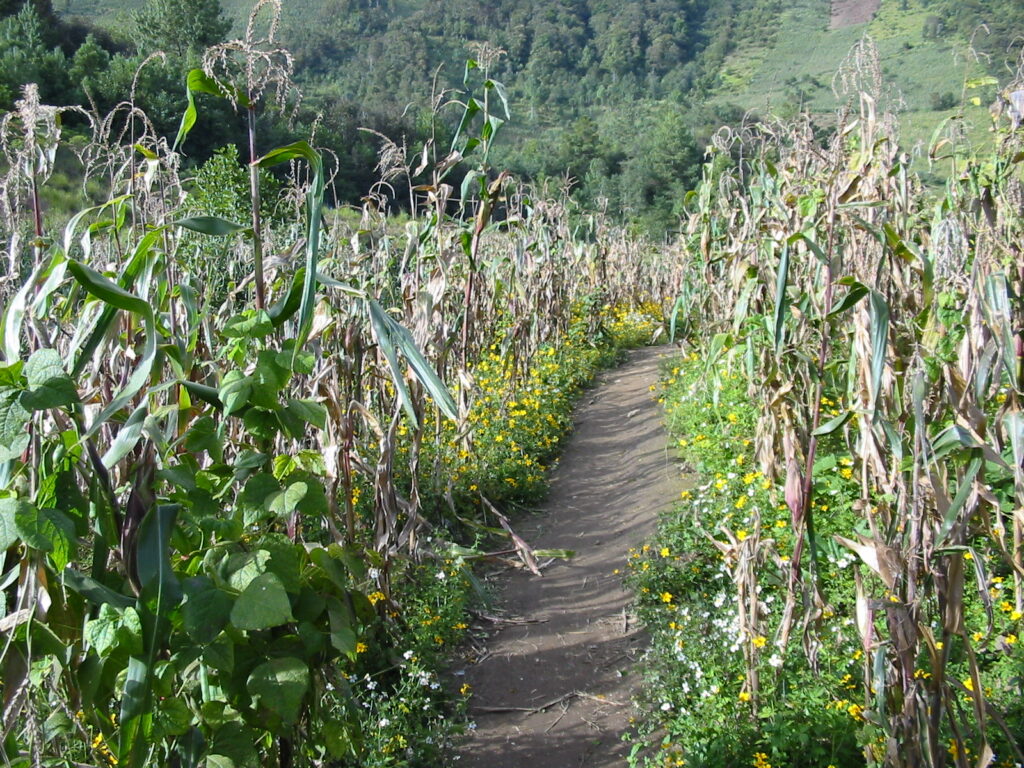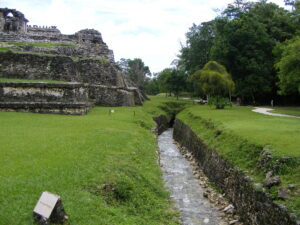
Imagine an ancient Maya city in its heyday. You will probably see its ceremonial core, with lofty pyramids, elevated palaces, extensive plazas, and everything is either painted bright red, or blinding white. You notice courtiers strolling along private patios, and servants rushing in all directions with their daily tasks. Perhaps there you can catch a glimpse of the ruler, sitting on his cushioned throne somewhere in the guts of a complicated maze of corridors in his palace. There is a sound of a gentle breeze blowing through the roofcombs, and a murmur of indistinguishable conversations. Faint smells of food mix with those of flowers… Then you step outside of the core, and everything changes. Perishable architecture intertwines with small houselot gardens, there are people everywhere, and they all seem to be shouting. Dogs are barking, some turkeys block your way, kids play in a muddy puddle, and you feel nauseous because of the ever-present smell of human waste mixed with odors of organic decay…
Hang on, hang on! Is that really a plausible picture?
Why are archaeologists studying phosphorus in the soil?
Archaeologists have long acknowledged the correlation between phosphorus quantities in the soil, and some domestic activities, especially those involving food preparation and disposal of the organic waste. It has been argued that high phosphorus concentrations constitute a marker of intensive agricultural activities in the form of fertilization. According to a widely accepted model, the Maya commoners were carrying their own excrement to their gardens and fields in order to replenish the soil nutrition elements, or else, using the milpas and gardens as toilets. Some scholars even suggested that pottery sherds found in abundance within middens in the vicinity of households were in fact used as an equivalent of toilet paper.

© F. Hanneforth, published under CC BY-SA 3.0
However, human waste is not a good fertilizer, at least not without some processing. Composting is required in order to kill the parasites and the ubiquitous E. coli bacteria that can be lethal if (re)ingested. Besides, composting also slightly diminishes the olfactory impact of fertilization. From a technical point of view, the climate in the Maya area is perfect for composting processes. Natural heat accelerates the fermentation of a compost heap, and then a chain reaction of sorts occurs that leads to formation of the night-soil. But if compostation pits indeed existed, they must have left a massive archaeological footprint in the form of hyper-phosphorus soil patches. So far none of these have been discovered, however, admittedly, soil-sampling was performed on a handful of sites only.

© J.Szymański, published under CC BY-SA 4.0
Stinky problem
The milpas that were cultivated in the swidden cycle could have been replenished by the ashes, but agricultural terraces and houselot gardens would hardly be left fallow, and as such requested some sort of an intensive agricultural method. It is imaginable that the terraces were periodically covered with composted human waste, but the gardens must have been fertilized with other kinds of organic refuse from household middens – otherwise the stench, multiplied by the number of households, would not only render the common parts of the city uninhabitable, but would also penetrate the patios and palaces of the refined nobility. Besides, any given garden or terrace can be covered with only so much compost at one time, and human settlements guarantee a constant surplus of this particular substance. Where did it all go? Was it being removed to ditches on the outskirts of the city? Or perhaps sealed in obsolete chultunes? And more importantly, where was the king going to see a man about a dog?

© J.Szymański, published under CC BY-SA 4.0
Where did the Maya go to the toilet?
Palace plans allow us to guess a generic function of particular spaces, and in a few lucky cases (such as in Aguateca) archaeological research revealed some more exact activities in some rooms. But so far no elite privies have been found. It is hard to imagine the king to be traversing the city towards a latrine on the outskirts once a day, but it seems equally awkward to assume that there were lines of servants carrying pots or baskets with elite excrements out of the palace and into the composting pits or straight onto terraces. Perhaps, then, there was some more discreet way?

© J.Szymański, published under CC BY-SA 4.0
One thing for sure – there are no sewers in the Maya palaces. The only exception of which I know comes from Palenque, where there is a vaulted, 100 m long “aqueduct” that passes under the palace, and some sloping, stuccoed piping. According to some scholars it might have fed a fountain, or was otherwise used in a water manipulation connected with ritual or decorative purposes rather than sanitation, especially that it would inevitably return to the Otulum river that provided water for a great portion of Palenque population. As in other Maya cities, we cannot expect high hygiene standards in the Classic period (surely not higher than those of ancient Rome, or Medieval Europe for that matter). How, then, did the Maya manage that particular issue?
The crappy problem awaits solving…
This article can be re-printed with photographs free of charge provided that the source is cited
Author:
Dr. Jan Szymański – from the Faculty of Archaeology, University of Warsaw, specializes in the analysis and interpretation of material remains of pre-Hispanic Mesoamerican and Lower Central American cultures. In particular, he focuses on the physical manifestations of cultural identity of past societies. Since 2018 he has been conducting archaeological research in El Salvador.
Editing: J.M.C., A.B.
Cover: Illustration generated in Midjourney, edited by K.K.
Promt: painting of a ancient mexican maya woman, dressed in native clothing , sitting with her legs joined at the knees on a chair in an empty room, facing us, historical painting, in the style of pre-raphaelite, phoenician art
REFERENCE:
Arnold D., H. Neff, R. Bishop, M. Glascock, 1999 Testing Interpretive Assumptions of Neutron Activation Analysis: Contemporary Pottery inYucatán, 1964–1994, in Material Meanings: Critical Approaches to the Interpretation of Culture, Chilton E. (ed.), pp. 61–84. University of Utah Press, Salt Lake City, UT.
Demarest A., 2004 Ancient Maya: The Rise and Fall of a Rainforest Civilization, Cambridge University Press, Cambridge, UK.
French K., Ch. Duffy, G. Bhatt, 2012 The Urban Hydrology and Hydraulic Engineering at the Classic Maya Site of Palenque, Water History 5(1):43-69.
Killon T., 1992 Gardens of Prhistory: The Archaeology of Settlement Agriculture in Greater Mesoamerica, University of Alabama Press, Tuscaloosa, AL.
Parnell J., R. Terry, Ch. Golden, 2001 Using In-Field Phosphate Testing to Rapidly Identify Middens at Piedras Negras, Guatemala, Geoarchaeology: An International Journal 16(8):855-873.
Parnell J., R. Terry, P. Sheets, 2002 Soil Chemical Analysis of Ancient Activities in Ceren, El Salvador: A Case Study of a Rapidly Abandoned Site, Latin American Antiquity 13(3):331-342.
Terry R., P. Hardin, S. Houston, S. Nelson, M. Jackson, J. Carr, J. Parnell, 2000 Quantitative Phosphorus Measurement: A Field Test Procedure for Archaeological Site Analysis at Piedras Negras, Guatemala, Geoarchaeology: An International Journal 15(2):151-166.
This text was funded by IDUB and the project entitled “Popularizing the research of the Department of Archaeology of the Americas at the Faculty of Archaeology” from Inicjatywa Doskonałości – Uczelnia Badawcza programme.
